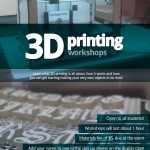Teaching material for “Introduction to 3D Printing” workshop
 Since my university’s Art department acquired their first Makerbot Replicator 3D printer at the beginning of this semester, one of my biggest goals has been to create some sort of educational infrastructure to channel the wave of student and faculty enthusiasm into effective and well-organized action. It would be very unreasonable to expect lesson plans to be adopted into existing curriculum from the beginning, so I decided to take a cue from the hackerspace and Maker movements and rely solely on extra-curricular workshops and events to make the learning process fun and interesting.
Since my university’s Art department acquired their first Makerbot Replicator 3D printer at the beginning of this semester, one of my biggest goals has been to create some sort of educational infrastructure to channel the wave of student and faculty enthusiasm into effective and well-organized action. It would be very unreasonable to expect lesson plans to be adopted into existing curriculum from the beginning, so I decided to take a cue from the hackerspace and Maker movements and rely solely on extra-curricular workshops and events to make the learning process fun and interesting.
While there are many, many cool topics that I’d love to teach in a workshop format, they all rely on a basic, fundamental understanding of 3D printing. It seemed pretty obvious, then, that the first workshop should be an all-encompassing introduction to the 3D printing workflow and the technology that makes it work. The tricky part is that the machine is the property of our Art department, and will therefore be mostly available to undergraduate Art students who may not have as much experience or interest in technology as a typical 3D printing enthusiast. The workshop would need to balance excitement and rewards with solid information that sticks in the students’ heads – forgetting even a seemingly small bit of information when trying to create a 3D print can result in hours of frustration and wasted material.
Teaching notes and tips
The first activity in the workshop is to present the Makerbot Replicator and visually demonstrate how it works by manually actuating the axes, showing the filament extrusion mechanism and answering any questions about how it actually produces plastic models. Students who seem to be disinterested at this point can be gently reassured that all the material in the workshop will be in the “quick start guide” that they can take home, and that there will be a hands-on activity in just a few minutes.
If possible, I think it’s a good idea to pass around objects that have been printed so everyone can get an intuitive understanding of the weight, texture and detail that the machine is capable of.
When the basic introduction is done, the students can then be walked through the 3-step process of getting a model from Thingiverse, slicing it and then printing it on the Replicator. Depending on the attendance and whether or not a material fee is charged, it may be a good idea to leave the actual printing until after the workshop. Help the students become familiar with Thingiverse and the core concepts of 3D-printing and it’s community, so that if they really get amped up and come back with ideas they have some platform to work on.
Only two students showed up to the first workshop I offered, so I was able to guide them through the process and actually printing their objects (scaled down) during the workshop. If attendance were higher, I would have them slice their object up and store the relevemt files (STL and S3G) someplace for me to access later. The idea was to print their objects within a week and deliver them to the students as a sort of achievement badge.